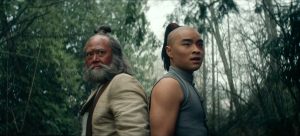Netflix’s Avatar: The Last Airbender, a live-action adaptation of the beloved animated series of the same name, has thus far been approached by fans with a mix of cautious optimism and cynical dread. While the diverse casting, vibrant design work, and longer runtime compared to the infamous M. Night Shyamalan adaptation have certainly given fans hope; the departure of the original show’s creators midway through production and Netflix’s largely poor track-record with live-action adaptations of animated works hasn’t exactly inspired confidence.
But now that the show’s first of a planned three seasons (One for each of the original show’s “Books”) has finally dropped, how does it fare? Has the beloved world of Avatar finally received a proper live-action treatment? Did it need a live-action treatment at all? And how does it compare to the acclaimed animated original?
Avatar: The Last Airbender is better than I thought it would be. And all of its best qualities certainly make it a step up from the 2010 Last Airbender movie or other Netflix live-action adaptations such as the 2021 Cowboy Bebop remake. But despite the fun I had watching the first season, I couldn’t help but feel like something was missing, especially in comparison to the original show. Why is that exactly? Let’s discuss.
Also Read: Netflix Is Not Making The Same Mistakes M. Night Shyamalan Did With Live-Action Avatar: The Last Airbender Series
Avatar: The Last Airbender Plot

Like its animated counterpart, Avatar: The Last Airbender takes place in a fantasy realm wherein people are divided into nations based on the four primary elements of water, earth, fire, and air; with some individuals, known as benders, even being able to control one of these four elements. Long ago, these four nations lived together in harmony. Then, everything changed when the Fire Nation attacked. (Come on, you know I had to put that somewhere in here.)
After a hundred years of war waged by the Fire Nation and the presumed loss of the Air Nomads, a young Waterbender named Katara and her hotheaded brother Sokka discover the last Airbender, a young boy named Aang, frozen in an iceberg. But he’s not just an Airbender, he’s the latest reincarnation of the Avatar, the only being capable of mastering all four elements. And Zuko, the banished prince of the Fire Nation, is determined to capture him.
With his brethren gone and both the world and himself in imminent danger, Aang teams up with Katara and Sokka on a globe-trotting adventure to master the other elements, stop Zuko and the other Firebenders, and learn what it truly means to be the Avatar.
Avatar: The Last Airbender Critique

The phrase I most frequently uttered while watching through Avatar: The Last Airbender‘s eight-episode first season was “Wait, we’re doing (insert plot point) NOW???” In an effort to fit the 20 half-hour episodes that make up Book 1’s story into eight 1-hour episodes; as well as make the show feel more tonally in line with other Netflix action dramas such as The Witcher or Stranger Things, many plot elements have been condensed, combined, remixed, or even excised entirely.
Some of this is understandable. Different mediums have different expectations and for as much as I love the original series, Book 1 in particular was not without its lower points. I certainly have no issue with a version of this story that opts to skip “The Great Divide” for example. But the sanding down and sometimes outright removal of the original’s comedic elements in particular makes the new one feel lacking in heart and character arcs.
I understand why they wouldn’t want to make one of the heroes of the story, Sokka, be so openly misogynistic, but the removal of this flaw, as well as generally toning down much of his arrogance, leaves the character without much to do. He’s never humbled because he doesn’t need to be, he never gets the big comedy moments that made the original show’s Sokka such a fan-favorite because this version doesn’t have time for comedy. There’s no real journey there.
This goes double for Aang, who despite a lovable and charming performance by Gordon Cormier, never really gets to be the fun and free-spirited scamp we all know and love. This Aang learns about the loss of the Air Nomads almost immediately and is from that point on determined to make up for it by focusing all of his time on learning how to best fulfill his role as the Avatar. No penguin sledding, no surfing with the whale koi, barely even any time with Appa and Momo.
But the one who suffers the most from this is Kiwantiio as Katara. Part of what made her more serious story work in the original is that she was playing off two goofballs in Aang and Sokka. Her being a capable and powerful young woman surrounded by two often idiotic young men provided compelling contrast and helped establish a strong group dynamic between the three. But because both Aang and Sokka are so serious now, Kiwantiio has nothing to work with. Which is a shame because she is genuinely good in the role.
Some of the loss in this dynamic is made up for by how talented the three leads really are. The aformentioned Gordon Cormier and Kiwantiio are excellent and even Ian Ousley as Sokka gets some moments to shine despite so much of what made his character work originally being absent here. But by removing so much of the comedy and sense of fun, the serious elements that were always there now feel less impactful because there’s nothing to compare them to.
Of course, by contrast, this means that the Fire Nation storylines, the most serious element of the original show, are without question the highlight here. Daniel Dae Kim is appropriately menacing as Fire Lord Ozai, Dallas Liu brings Zuko’s inner conflict to life with remarkable gusto, and the perfect mix of warmth and intensity Paul Sun-Hyung Lee brings to Iroh is by far the best translation from animation to live-action in the series so far. The scenes with him and Zuko are a genuine treat to watch.
The one exception to the Fire Nation stories as the highlight might be Elizabeth Yu as Azula, who has an ongoing subplot of her own despite famously only appearing in Book 1 at the very end as a tease for Book 2. Yu is great in the role, don’t get me wrong. She does a great job at capturing the manipulative “three steps ahead of everyone” slyness that made Azula such a compelling villain in the original. But because her character doesn’t do anything in Book 1’s story, her scenes feel like effective but unnecessary foreshadowing at best and pointless fanservice at worst.
Visually speaking, Avatar: The Last Airbender is genuinely great. Gorgeous set design captured beautifully by top-notch cinematography and shot composition with costumes, hair, and makeup ripped straight out of the original show while still managing to make everything feel organic to the world. And for those of you just here for live-action bending, you’ll get it in spades. The action scenes are a massive highlight, with stunning martial arts choreography and impactful hand-to-hand combat mixed in with impressive VFX work for the bending bringing everything from water whips to fire kicks to life in a way that feels grounded yet appropriately larger-than-life.
In Conclusion

Netflix’s Avatar: The Last Airbender is not a bad show by any means. It’s genuinely fun to watch, the actors all do a good job and bounce off each other well, and the vibrant color palette alongside the aforementioned excellent design work and action scenes make it consistently engaging visually, And much of the story following the major beats of the masterpiece that is the original mean that writing-wise it’s at least pretty good by default. But it pales in comparison to said original.
Every plot change makes the story less interesting, the lack of comic relief means the charm of the characters and the performances have a much harder time shining through, and the removal of character flaws in a misguided effort to modernize the story leave much of the journey feeling less like an epic saga and more like watching someone play a video game on New Game Plus. They already know everything, don’t ever seem to gain anything new, and skip all the charming little side quests along the way solely for the sake of keeping things moving.
If and when this show adapts Books 2 and 3, I hope they learn from this and provide more time to let these characters breathe. Show them having fun, let there be comedic and light-hearted moments so we know what our heroes are fighting for in the serious moments. As it stands, the new series does the job well enough, but if you’re searching for Avatar on Netflix, you’re probably still better off just rewatching the original.
7/10
Follow us on Facebook, Twitter, Instagram, and YouTube for more entertainment coverage.

